Day 28: Cheek by Jowl in the Forbidden City.
If you’re fortunate enough to visit Beijing, by all means plan to see the Forbidden City, home to 14 Ming emperors and 10 more from the Qing Dynasty. Like Tiananmen Square, it’s big, almost 180 acres in all. That means there will be a great deal of walking. And it’s not all flat. There are flights of stone steps. Lots of them.
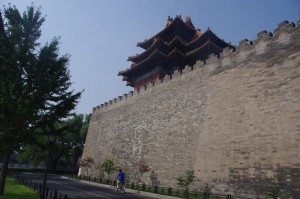 The Forbidden City dates back to the very early 1400s and wasn’t opened to visitors in 1925, almost 15 years after the last emperor was overthrown. But for all those years when emperors were in residence, the Chinese were serious about protecting them. There is a 30-foot wall around the entire area. And a moat – 50-plus feet wide and six feet deep.
The Forbidden City dates back to the very early 1400s and wasn’t opened to visitors in 1925, almost 15 years after the last emperor was overthrown. But for all those years when emperors were in residence, the Chinese were serious about protecting them. There is a 30-foot wall around the entire area. And a moat – 50-plus feet wide and six feet deep.
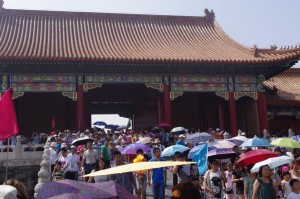 Expect crowds if you go … big crowds. It was just over 90 degrees on the day I was there and by the time our tour of the place ended, I was very tired and more than ready for a cold beer. Looking at these photos now, I’m sure that the constant press of all those people for several hours contributed to the fatigue we all felt. Our guide estimated the crowd that day at 40,000. But, he said, it’s often twice that or even more on big holidays. Wow!
Expect crowds if you go … big crowds. It was just over 90 degrees on the day I was there and by the time our tour of the place ended, I was very tired and more than ready for a cold beer. Looking at these photos now, I’m sure that the constant press of all those people for several hours contributed to the fatigue we all felt. Our guide estimated the crowd that day at 40,000. But, he said, it’s often twice that or even more on big holidays. Wow!
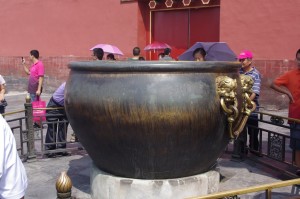 There are dozens of these huge copper and iron vats located throughout the Forbidden City, the oldest ones dating all the way back to the late 1400s. The buildings, even the emperors’ quarters, were built of wood and the vats were kept filled with water used to fight fires. And there were fires, ultimately reducing the entire complex to a mere 8700 rooms, down from the original 9,999. (Nine, you see, was considered a lucky number.) By the way, charcoal fires were built around the bases of these vats in winter to keep the water from freezing. Amazing what you can do with no limit to the money or manpower at your disposal, eh?
There are dozens of these huge copper and iron vats located throughout the Forbidden City, the oldest ones dating all the way back to the late 1400s. The buildings, even the emperors’ quarters, were built of wood and the vats were kept filled with water used to fight fires. And there were fires, ultimately reducing the entire complex to a mere 8700 rooms, down from the original 9,999. (Nine, you see, was considered a lucky number.) By the way, charcoal fires were built around the bases of these vats in winter to keep the water from freezing. Amazing what you can do with no limit to the money or manpower at your disposal, eh?
I mentioned earlier that the Chinese guide for our group carried a small transmitter and microphone and that each of us heard his narration and comments through a little receiver and ear bud we’d been given. Indeed, most tour groups used that excellent system. There were other groups, however, that got their information from tour guides screeching through little bullhorns and any ear-bud narration was obliterated when these obnoxious people came within 100 feet. With a repressive government able to do any damn thing it wants, cracking down on these devilish devices would be an excellent place to start.
We entered the Forbidden City through the South Gate and headed straight ahead: up long flights of stone stairs, through crowded passageways, into courtyards, down other stairs, out onto huge open areas, up still more stairs and through decorative arches — plodding on and on and on. By the time it came in sight, the North Gate wasn’t just another interesting structure, it was a goal. Our finish line! Hot, tired and seriously in need of cold beer, we staggered through the gate desperately looking for our big, beautiful air-conditioned bus.
But it was not to be … at least not yet. Instead, we found ourselves in the Imperial Gardens, quite a beautiful area mercifully shaded by very large trees and, truthfully, a very nice way to decompress from the press of crowds and the heat within those 30-foot walls behind us.
Bottom line: The Forbidden City absolutely must be on your list of places to see in Beijing. And the very best advice I can give you is to make it the only place you visit on that day. Most especially if you happen to be there on one of the big Chinese holidays! Take your time … bring bottled water … and (I’m quoting our guide here) keep one hand on your wallet. But go!
Next: The Great Wall.

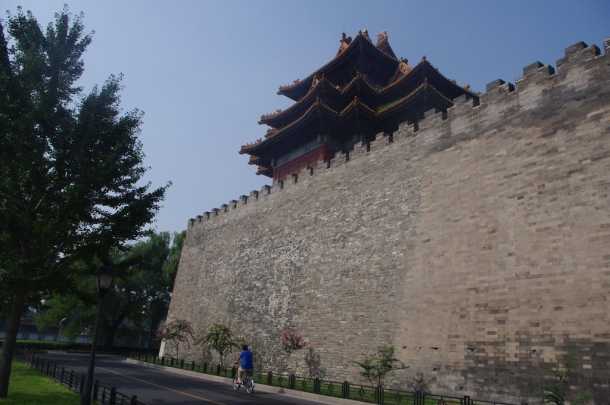
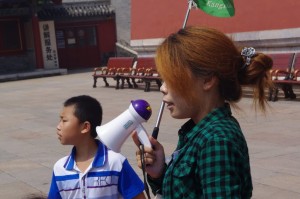
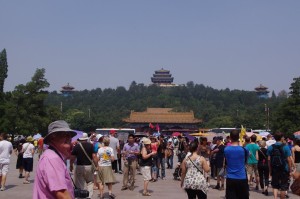
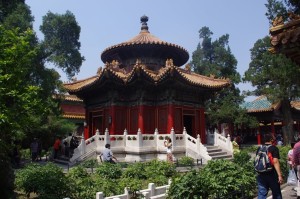


There’s a secret knock, John. Don’t ask what happens when you get it wrong!
if it’s Forbidden, how do you get in?
Just kidding! This is delightful, interesting stuff.
Envious!